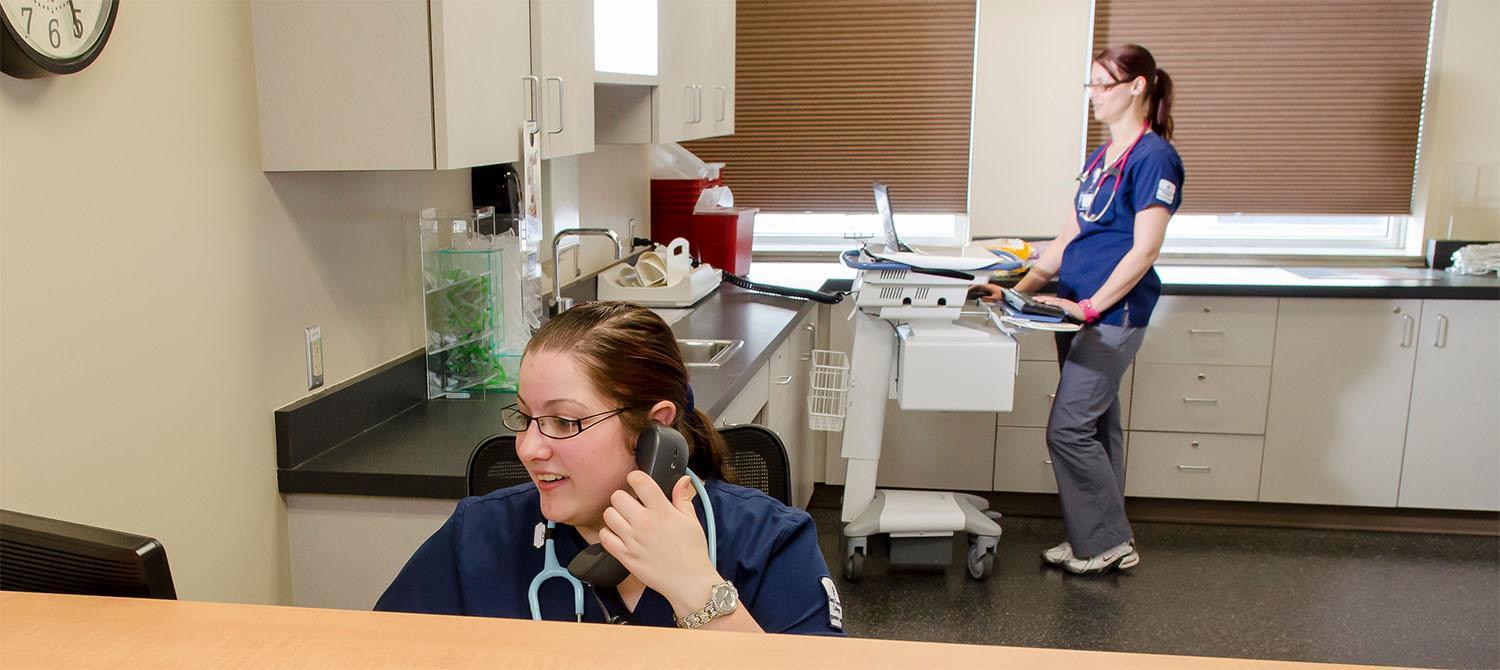Home>Misc>Featured>How To Become A Home Health Aide For Family Member


Featured
How To Become A Home Health Aide For Family Member
Modified: January 2, 2024
Learn how to become a featured home health aide for your family member and provide them with compassionate and professional care. Take the first step towards a rewarding career in assisting and supporting your loved ones.
Introduction
Welcome to the world of being a home health aide for a family member. Whether you have made this decision out of love and dedication or necessity, becoming a home health aide for a family member is a noble and rewarding role. It allows you to provide essential care, support, and assistance to a loved one in the comfort of their own home.
Being a home health aide for a family member is a significant responsibility that requires compassion, patience, and a willingness to learn. It can be both physically and emotionally demanding, but the bond and connection you build with your family member make it all worthwhile.
In this article, we will guide you through the necessary steps to become a proficient home health aide for your family member. We will cover topics such as assessing their needs, developing care plans, learning basic medical skills, assisting with daily living activities, promoting a safe environment, and much more. By following these guidelines, you will be equipped to provide the best possible care for your family member.
It is crucial to note that while you may be taking on the role of a home health aide, it is essential to consult with healthcare professionals and seek their guidance and expertise. They can provide valuable advice, resources, and support to ensure the well-being of your family member.
Now, let’s dive into the details of how to become an effective and compassionate home health aide for your family member!
Understanding the Role of a Home Health Aide
Before embarking on your journey as a home health aide for your family member, it is crucial to have a clear understanding of the role and responsibilities involved. A home health aide is a trained professional who provides personalized care and support to individuals in need, ensuring their physical and emotional well-being.
As a home health aide, your primary role is to assist your family member with various daily activities, such as bathing, dressing, meal preparation, medication management, and mobility assistance. You will also be responsible for monitoring their health status, observing any changes in condition, and reporting them to the healthcare professionals.
Furthermore, a home health aide may be required to perform basic medical tasks, such as taking vital signs, administering medications, and providing wound care under the supervision of healthcare professionals. However, it is crucial to note that the scope of practice for a home health aide varies depending on the state regulations and the specific needs of the individual.
Additionally, a home health aide holds a vital role in providing emotional support and companionship to their family member. This involves actively listening, engaging in meaningful conversations, and offering encouragement to enhance the overall well-being and quality of life for the individual.
Understanding the boundaries of the home health aide role is also significant. While you may have a close relationship with your family member, it is important to maintain a professional approach to ensure the provision of consistent and effective care. Striking the right balance between compassion and professionalism is key to creating a positive caregiving environment.
By comprehending the role of a home health aide, you are better prepared to fulfill your responsibilities and provide the highest level of care for your family member. The next step is assessing their specific needs to develop personalized care plans and schedules.
Assessing the Needs of Your Family Member
When undertaking the role of a home health aide for your family member, it is crucial to assess their needs comprehensively. By understanding their specific requirements, you can develop a personalized care plan that meets their physical, emotional, and medical needs.
Start by having an open and honest conversation with your family member about their current health condition, any preexisting medical conditions, and their functional abilities. This will provide valuable insights into their limitations, challenges, and areas where they require assistance.
Next, consider their daily living activities, such as personal hygiene, dressing, bathing, and grooming. Evaluate their mobility level and ability to move around the house independently. Determine if they require assistance with meal preparation and eating. Assess their medication management needs and any medical equipment they may rely on.
Observe their cognitive and emotional well-being. Are they experiencing any memory issues or confusion? Do they express feelings of anxiety, depression, or loneliness? Understanding their emotional state is crucial as it directly impacts their overall well-being.
Furthermore, identify any potential safety concerns in the home environment. Assess if modifications or assistive devices are needed to ensure their safety and mobility. Consider factors such as fall risks, accessibility, and adequate lighting.
It is essential to involve healthcare professionals, such as doctors, nurses, or therapists in the assessment process. They can provide valuable input and expertise in evaluating your family member’s medical condition and specific care needs. Consider scheduling appointments to address any concerns or gather recommendations.
By gathering information from various sources, including your family member, healthcare professionals, and your own observations, you can establish a comprehensive understanding of their needs. This assessment will serve as a foundation for developing individualized care plans and schedules that promote their well-being while respecting their independence and preferences.
Once you have assessed your family member’s needs, it is time to develop care plans and schedules that address their specific requirements.
Developing Care Plans and Schedules
Developing care plans and schedules is a crucial step in providing effective and organized care as a home health aide for your family member. These plans serve as roadmaps, outlining the tasks, activities, and interventions required to meet their specific needs and promote their well-being.
Start by creating a comprehensive care plan that encompasses all aspects of their daily living activities, medical needs, and emotional support. Break down the plan into specific tasks and assign appropriate timeframes for each activity.
Consider their personal preferences and involve them in the decision-making process as much as possible. This way, you can tailor the care plan to their unique needs and ensure their active involvement in their own care.
When developing the care plan, it is crucial to prioritize the most critical tasks and activities. This ensures that the essential needs are met while allowing flexibility for any unexpected changes or emergencies that may arise.
Alongside the care plan, establish a schedule that balances their daily routine and the necessary care activities. This schedule should include regular meal times, medication administration, personal care tasks, exercise or therapy sessions, and designated time for social interaction and leisure activities.
Consider the time and energy required for each task when scheduling them. Allow for breaks and rest periods to prevent caregiver burnout and to ensure you can provide the best care possible. Flexibility is key in accommodating their needs and adjusting the schedule as required.
Communicate the care plan and schedule clearly with your family member, ensuring they understand the expectations and proposed activities. Address any concerns or questions they may have and be receptive to their feedback and suggestions.
It is essential to regularly review and update the care plans and schedules as your family member’s needs evolve. As their health condition changes or as they progress in their recovery, adjustments to the plan may be necessary to provide optimal care.
By developing comprehensive care plans and schedules, you can ensure that your family member receives the necessary assistance and support while maintaining a structured and organized caregiving routine. With the care plans in place, you are ready to learn the basic medical skills and techniques required for your role as a home health aide.
Learning Basic Medical Skills and Techniques
As a home health aide for your family member, it is essential to acquire basic medical skills and techniques to provide safe and effective care. While you may not be performing complex medical procedures, having a basic understanding of certain skills will enable you to address their healthcare needs.
Start by familiarizing yourself with vital signs monitoring, such as measuring blood pressure, temperature, pulse, and respiratory rate. Learn how to properly use the necessary instruments and understand what constitutes normal and abnormal ranges for each vital sign.
Next, gain knowledge in basic first aid techniques, such as wound care, bandaging, and managing minor injuries. Know how to clean wounds, apply appropriate dressings, and recognize signs of infection or complications that may require medical attention.
It is also important to understand medication management. Learn how to properly administer medications, including oral medications, topical treatments, and injections if necessary. Familiarize yourself with common medications and their potential side effects or interactions.
Furthermore, develop an understanding of infection control procedures to maintain a clean and safe environment. Learn proper hand hygiene techniques, use of personal protective equipment (PPE), and how to prevent the spread of infectious diseases.
Consider undergoing training in CPR (Cardiopulmonary Resuscitation) and basic life support techniques. This knowledge can be invaluable in the event of a medical emergency, allowing you to provide immediate assistance until professional help arrives.
Seek educational resources, such as online courses, training programs, or workshops, to enhance your knowledge and skills. Many healthcare organizations and community centers offer specialized courses for home health aides that cover these essential medical skills.
Remember that while you may acquire these basic medical skills, it is crucial to work within the limitations of your role as a home health aide. Always consult with healthcare professionals, such as doctors or nurses, for specific medical advice or procedures.
By learning and practicing basic medical skills and techniques, you can confidently provide the necessary care and address the medical needs of your family member. With these skills in your arsenal, you can move on to assisting them with their activities of daily living.
Assisting with Activities of Daily Living
Assisting your family member with their activities of daily living (ADLs) is a significant part of your role as a home health aide. ADLs are the basic self-care tasks that individuals perform on a daily basis to maintain their hygiene, health, and well-being.
When it comes to ADLs, each individual may have different levels of ability and independence. It is important to approach these tasks with patience and respect, supporting your family member in maintaining their dignity and autonomy as much as possible.
One of the main ADLs is personal hygiene, which includes activities such as bathing, grooming, and oral care. Assist your family member with bathing or showering, ensuring their safety and comfort. Help them with hair brushing, shaving, and dental care to maintain proper hygiene.
Dressing is another essential ADL. Offer assistance in choosing appropriate clothing and help with putting garments on or taking them off. Consider their preferences and comfort, and involve them in the decision-making process as much as possible.
Meal preparation and feeding are also important tasks. If your family member is capable, encourage their participation in food choices and preparation. Assist with meal planning, cooking, and setting up food in a way that accommodates their specific dietary needs and preferences.
Mobility assistance is crucial for individuals with limited mobility. Provide support and assistance as needed, such as helping with transferring from one position to another, using mobility aids, or assisting with ambulation. Ensure their safety during mobility tasks and encourage regular movement to prevent stiffness and muscle weakness.
Assist with toileting needs, especially for individuals with mobility impairments or those who require assistance. Be sensitive to their privacy and maintain their dignity throughout this process. If necessary, use appropriate assistive devices, such as grab bars or raised toilet seats, to ensure their safety.
Depending on their abilities, your family member may require assistance with other ADLs, such as managing finances, communication, or medication management. Accommodate their needs and provide support accordingly.
While assisting with ADLs, it is important to encourage independence and promote their active participation as much as possible. empower them to perform tasks on their own to the best of their abilities, only stepping in when necessary.
By providing practical support and assistance with ADLs, you can ensure your family member maintains their health, hygiene, and independence. It is now important to create a safe and supportive environment for them.
Promoting a Safe and Supportive Environment
Creating a safe and supportive environment is crucial for the well-being and comfort of your family member as a home health aide. By taking proactive measures to promote safety and provide emotional support, you can ensure your family member feels secure and valued in their own home.
Start by conducting a thorough assessment of their living space, identifying any potential hazards or risks. Remove obstacles and clutter that may cause falls or accidents. Install safety equipment, such as handrails, grab bars, and non-slip mats, in areas where they are needed.
Ensure that there is adequate lighting throughout the home, especially in hallways, staircases, and bathrooms. Use nightlights to prevent falls during nighttime. Regularly inspect and maintain electrical systems and appliances to prevent fire hazards.
Create a supportive atmosphere by fostering open communication and active listening. Encourage your family member to express their feelings, concerns, and preferences. Respect their choices and involve them in decision-making regarding their care and living arrangements.
Establish a routine that provides structure and predictability, as it can help reduce anxiety and confusion. Maintain a consistent schedule for meals, medications, activities, and rest. Adequate rest and sleep are essential for their overall well-being and should be prioritized.
Encourage social interaction and engagement with family, friends, and the community. Organize social activities, schedule regular visits, or arrange transportation for outings. This helps prevent loneliness and isolation, promoting a sense of belonging and social connectedness.
Educate yourself and your family members about your family member’s specific medical needs and conditions. Understand any potential risks, warning signs, or emergencies that may arise. Create a contingency plan in case of unforeseen events, such as medical emergencies.
Implement proper infection control practices, such as regular handwashing, disinfection of surfaces, and the appropriate disposal of medical waste. Keep a stock of necessary supplies, such as gloves, masks, and hand sanitizers, to maintain a clean and germ-free environment.
Regularly check and maintain any medical equipment they may use, such as wheelchairs, walkers, or oxygen tanks. Follow proper usage and storage guidelines to ensure their functionality and safety.
Lastly, foster a nurturing and positive environment by offering emotional support and encouragement. Be patient, empathetic, and understanding towards your family member’s emotional needs. Celebrate their achievements and milestones, no matter how small, to uplift their spirits.
By promoting a safe and supportive environment, you establish a foundation for their overall well-being and happiness. Next, we will explore the importance of effective communication in your role as a home health aide.
Communicating Effectively with Your Family Member
Effective communication is key to building a strong and trusting relationship with your family member as a home health aide. It allows you to understand their needs, provide support, and ensure their overall well-being. Implementing clear and respectful communication strategies is essential for a positive caregiving experience.
Start by actively listening to your family member. Give them your full attention, maintain eye contact, and show genuine interest in what they have to say. Encourage them to express their thoughts, concerns, and preferences, and validate their feelings. This helps foster an environment of open communication and trust.
Use clear and simple language when speaking to your family member. Avoid complex medical jargon or technical terms that may confuse or overwhelm them. Break down information into smaller, more manageable chunks to facilitate understanding.
Non-verbal communication also plays a significant role in effective communication. Pay attention to your body language, facial expressions, and tone of voice. Maintain a calm and reassuring demeanor, ensuring that your non-verbal cues align with your verbal messages.
Respect the privacy and confidentiality of your family member. Keep their personal information and discussions confidential unless required for their care or with their explicit consent. Prioritize their autonomy and rights as individuals.
Be patient and understanding in your interactions. Your family member may need extra time to process information or express their thoughts. Avoid interrupting or rushing them. Practice empathy and validate their emotions, offering support and reassurance when needed.
Encourage your family member’s active participation in their own care by seeking their input and involving them in decision-making processes. Respect their choices and preferences, understanding that they have the right to make decisions about their own well-being.
Ask open-ended questions to encourage conversation and keep communication flowing. This allows your family member to share their thoughts and feelings more freely. Avoid yes or no questions, as they may limit their ability to express themselves fully.
Seek clarification if you are unsure about something your family member has communicated. It is better to ask for clarification than to make assumptions. This demonstrates your commitment to understanding their needs and providing the best care possible.
Regularly check in with your family member to assess their satisfaction with the care and support they are receiving. Encourage feedback and suggestions for improvement. Continuous communication and feedback allow you to make adjustments to better meet their needs.
Remember that effective communication is a two-way street. It not only involves expressing yourself but also actively listening and understanding your family member’s perspective. By practicing effective communication strategies, you can build a strong connection with your family member and provide the support they need.
Providing Emotional Support and Encouragement
As a home health aide for your family member, providing emotional support and encouragement is just as important as meeting their physical needs. Emotional well-being plays a significant role in overall health and can greatly impact their quality of life. Here are some ways to provide effective emotional support and encouragement:
1. Show empathy and understanding: Take the time to understand and empathize with your family member’s emotions. Validate their feelings and let them know that you are there to support them through both the ups and downs.
2. Be a good listener: Practice active listening, allowing your family member to express their thoughts and concerns. Create a safe space where they feel comfortable sharing their feelings, and avoid judgment or interruption.
3. Offer reassurance and encouragement: Provide words of encouragement to uplift their spirits and boost their confidence. Celebrate their achievements, no matter how small, and remind them of their strengths and abilities.
4. Promote social interaction: Encourage social connections by organizing visits from friends and family members or arranging activities that foster social engagement. Loneliness and isolation can have a negative impact on emotional well-being, so facilitating social interactions is vital.
5. Engage in meaningful activities: Find activities that your family member enjoys and that bring them a sense of purpose. This could include hobbies, games, or even creative outlets. Engaging in meaningful activities can provide a sense of fulfillment and joy.
6. Create a positive environment: Foster a positive atmosphere by maintaining a calm and supportive demeanor. Avoid negative comments or criticisms and focus on highlighting their accomplishments and positive attributes.
7. Practice patience and understanding: It’s important to remember that your family member may have good days and bad days. Be patient during moments of frustration or mood swings. Understand that their emotions may be influenced by their medical condition or other factors beyond their control.
8. Encourage self-care: Remind your family member of the importance of self-care and help them prioritize activities that promote their well-being, such as engaging in relaxation techniques, taking time for hobbies, or pursuing interests that bring them joy.
9. Seek professional support if needed: If your family member is experiencing significant emotional distress, it may be beneficial to involve a mental health professional. They can help assess their emotional well-being and provide appropriate interventions or therapies.
Providing emotional support and encouragement can greatly enhance your family member’s overall well-being and contribute to a positive caregiving experience. By being empathetic, patient, and uplifting, you can create a nurturing environment that fosters emotional well-being.
Recognizing Signs of Medical Emergencies
As a home health aide for your family member, it is essential to be vigilant and able to recognize signs of medical emergencies. Promptly identifying these signs allows you to take immediate action and seek appropriate medical assistance. Here are some common signs of medical emergencies to watch for:
1. Chest pain or discomfort: Severe or persistent chest pain can indicate a heart attack or other cardiac-related issues. It may be accompanied by shortness of breath, sweating, or pain radiating to the arm, jaw, or neck.
2. Difficulty breathing: Sudden shortness of breath or difficulty in breathing may be a sign of a respiratory emergency. It could be caused by conditions such as asthma, pneumonia, or a pulmonary embolism.
3. Loss of consciousness: If your family member suddenly loses consciousness or appears confused, it may signify a serious medical condition, such as a stroke or seizure. Pay attention to any changes in their level of responsiveness.
4. Profuse bleeding: Uncontrolled bleeding that doesn’t stop or excessive bleeding from wounds may require immediate medical attention. Apply pressure to the bleeding site and seek medical assistance.
5. Severe pain or discomfort: Intense or unbearable pain that does not subside may indicate a medical emergency. It could be related to conditions such as kidney stones, appendicitis, or a severe injury.
6. Rapid or irregular heartbeat: If your family member experiences a sudden increase in heart rate or develops an irregular heartbeat, it may suggest a cardiac emergency. This includes symptoms like palpitations, dizziness, or chest discomfort.
7. Sudden changes in mental state: Abrupt confusion, disorientation, or altered mental status can be a sign of a medical emergency. It could be related to conditions such as infection, severe dehydration, or medication side effects.
8. Severe allergic reactions: Swelling of the face, lips, or throat, along with difficulty breathing and a rash, could indicate a severe allergic reaction or anaphylaxis. Administer any prescribed emergency medication, such as an epinephrine auto-injector, and seek immediate medical help.
9. Signs of stroke: Remember the acronym FAST – Face drooping, Arm weakness, Speech difficulties, Time to call emergency services. These symptoms may indicate a stroke and require immediate medical attention.
10. Suicidal thoughts or behaviors: If your family member expresses thoughts of self-harm or suicide, take it seriously and seek immediate professional help. Contact emergency services or a mental health crisis hotline.
It is crucial to have emergency contact numbers readily available and to know how to access emergency medical services in your area. Stay calm and provide reassurance to your family member while waiting for help to arrive.
Remember, every medical emergency is unique, and it is important to trust your instincts. If you suspect something is seriously wrong, do not hesitate to seek immediate medical assistance. Your quick response can make a critical difference in ensuring the well-being and safety of your family member.
Managing Medications and Medical Equipment
As a home health aide for your family member, you may be responsible for managing their medications and ensuring the proper use of medical equipment. Safely and effectively managing medications and equipment is vital in maintaining their health and well-being. Here are some important considerations:
1. Medication management:
- Organize medications: Keep medications properly sorted and labeled, ensuring they are easily accessible when needed.
- Follow the medication schedule: Administer medications according to the prescribed schedule, paying attention to the correct dosage and timing.
- Medication storage: Store medications in a cool, dry place, away from direct sunlight or heat sources. Be mindful of expiration dates and dispose of expired medications properly.
- Monitor for side effects: Observe your family member for any adverse reactions or side effects from their medications. Report any concerns to their healthcare provider.
- Communicate with healthcare professionals: Keep in regular contact with doctors or pharmacists to discuss any medication changes or concerns.
2. Medical equipment:
- Ensure familiarity: Familiarize yourself with the proper use and maintenance of any medical equipment your family member requires, such as mobility aids, respiratory equipment, or specialized devices.
- Regular checks: Regularly inspect the equipment for any signs of damage or malfunction. Follow the manufacturer’s guidelines for cleaning and maintenance.
- Assist with usage: Provide assistance, when necessary, in properly using medical devices or equipment, ensuring your family member understands how to use them safely and effectively.
- Get professional guidance: Seek guidance from healthcare professionals or equipment suppliers if you have any questions or concerns about the equipment.
3. Communication with healthcare professionals:
- Report changes: Keep healthcare professionals updated on any changes in your family member’s condition or any concerns related to their medications or equipment.
- Ask questions: Seek clarification about medication instructions or equipment usage if you are unsure. It’s better to ask for guidance to ensure proper management.
- Maintain a medication list: Keep an updated list of all medications your family member is taking, including dosage and frequency. Share this list with healthcare professionals during appointments or in case of emergency.
- Attend healthcare appointments: Accompany your family member to healthcare appointments to provide important information to the healthcare team and to ask any questions you may have.
By effectively managing medications and medical equipment, you are contributing to the overall health and well-being of your family member. Regular communication with healthcare professionals, proper organization of medications, and careful usage of medical equipment are essential in providing safe and effective care.
Documenting and Reporting Care Activities
Documenting and reporting care activities is an important aspect of being a home health aide for your family member. Keeping accurate records and providing clear reports ensures continuity of care, enhances communication with healthcare professionals, and facilitates effective coordination of their overall healthcare. Here are some key considerations for documenting and reporting care activities:
1. Documentation:
- Record observations: Document any changes or observations related to your family member’s physical, mental, or emotional state. This includes vital signs, symptoms, and any notable events or incidents.
- Document care provided: Keep a record of the care tasks you have completed, such as medication administration, wound dressings, assistance with activities of daily living (ADLs), and any therapeutic interventions.
- Include details: Be specific in your documentation, noting dates, times, and details of activities performed. Describe any deviations from the usual routine or any concerns that arise during the care process.
- Use clear and concise language: Write in a clear and easily understandable manner, using objective language and avoiding jargon. Be consistent in your documentation style to ensure accuracy and clarity.
- Follow privacy laws: Adhere to privacy laws and regulations when documenting personal or confidential information. Maintain the confidentiality and security of your family member’s health records.
2. Reporting:
- Communicate with healthcare professionals: Report any significant changes in your family member’s condition promptly to their healthcare team. This includes new symptoms, worsening symptoms, or any concerns that may require medical attention.
- Provide accurate and timely information: Report care activities and observations in a timely manner, ensuring healthcare professionals have the most up-to-date information to guide their decision-making process.
- Be thorough and informative: Clearly communicate your family member’s response to care interventions, any adverse reactions or side effects experienced, and any challenges encountered during the care process.
- Listen and ask questions: Listen attentively to healthcare professionals and ask questions to gain a better understanding of their recommendations or instructions. Seek clarification if needed to ensure accurate reporting.
- Collaborate and share information: Maintain open and collaborative communication with the healthcare team, sharing the information you have documented and reporting any feedback or input given by healthcare professionals.
Remember, accurate documentation and reporting are vital for facilitating coordinated care and ensuring the well-being of your family member. It supports effective communication, enables informed decision-making, and helps track progress over time. By taking the time to document and report care activities, you contribute to the overall quality and continuity of their care.
Seeking Professional Help and Support
Being a home health aide for your family member is a significant responsibility that may come with challenges and uncertainties. It is important to recognize the value of seeking professional help and support to ensure the best care possible for your loved one. Here are some reasons why seeking professional help is crucial:
1. Expertise and guidance: Healthcare professionals bring specialized knowledge and expertise that can greatly benefit your family member. They can provide guidance on specific medical conditions, treatment options, and interventions, ensuring your loved one receives appropriate care.
2. Diagnostic and therapeutic capabilities: Professionals have access to diagnostic tests, examinations, and medical resources that can help accurately diagnose and manage your family member’s health condition. Their recommendations are based on evidence-based practices and current medical research.
3. Access to a multidisciplinary team: Healthcare professionals work as part of a multidisciplinary team, including doctors, nurses, therapists, and social workers. This collaborative approach ensures comprehensive and well-rounded care for your family member, addressing their physical, emotional, and social needs.
4. Medication management: Professionals can provide expert guidance on medication management, including prescribing appropriate dosages, monitoring potential side effects, and adjusting medications as needed. They can also help prevent medication interactions or complications.
5. Emotional support for you and your family member: Professional support extends beyond the medical aspects. They can offer emotional support to both you and your family member, assisting with coping strategies, addressing emotional challenges, and providing resources for mental health support.
6. Assistance with complex care needs: If your family member has complex care needs or requires specialized interventions, seeking professional help ensures that they receive the appropriate care and attention necessary to manage their condition effectively.
7. Education and training: Professionals can provide education and training to help you better understand your family member’s health condition, their specific care needs, and any ongoing management or treatment plans. This knowledge equips you with the skills and confidence to provide optimal care.
8. Respite and support services: Seeking professional help can also provide access to respite care or support services, allowing you to take a break when needed and attend to your own self-care. This can help prevent caregiver burnout and ensure your well-being.
Remember, seeking professional help does not diminish your role or commitment as a home health aide. It enhances the care you provide by utilizing the expertise of professionals and working collaboratively towards the well-being of your family member.
Don’t hesitate to reach out to healthcare professionals, community resources, support groups, or other caregiver networks for guidance, assistance, and support. Together, you can provide the best possible care for your family member while also taking care of yourself as a caregiver.
Taking Care of Yourself as a Home Health Aide
As a home health aide for your family member, it is easy to prioritize their well-being while neglecting your own. However, it is crucial to prioritize self-care to maintain your own physical, mental, and emotional well-being. Here are some important considerations for taking care of yourself as a home health aide:
1. Set boundaries: Establish clear boundaries between your caregiver role and personal life. Set realistic expectations for yourself and communicate your limits to your family member and other family members involved in their care.
2. Seek support: Reach out to friends, family, or support groups who can provide emotional support and understanding. Join caregiver support groups where you can connect with others who are going through similar experiences.
3. Take breaks: Allow yourself regular breaks to rest and recharge. Use this time to engage in activities you enjoy, such as hobbies, exercise, reading, or spending time with loved ones. Taking breaks is essential for preventing burnout.
4. Prioritize self-care activities: Make time for activities that promote your own well-being, such as exercise, healthy eating, relaxation techniques, and getting enough sleep. Prioritizing self-care helps you maintain physical and mental health.
5. Practice stress management techniques: Find healthy ways to manage stress, such as deep breathing exercises, meditation, yoga, or engaging in activities that bring you joy and relaxation.
6. Delegate tasks: Don’t hesitate to ask for help and delegate tasks to other family members or trusted individuals. Sharing the responsibilities of caregiving can relieve some of the burdens and reduce stress.
7. Stay informed: Stay up to date with relevant resources and information related to caregiving and your family member’s condition. Knowledge empowers you to better navigate their care and make informed decisions.
8. Take advantage of respite care: Explore respite care options that allow you to take time off from caregiving. Respite care services provide temporary relief and give you the opportunity to focus on your own needs without compromising your family member’s care.
9. Keep a positive mindset: Cultivate a positive attitude and focus on the rewarding aspects of your caregiver role. Celebrate small victories and find joy in the moments shared with your family member.
10. Regularly check in with healthcare professionals: Schedule routine check-ups or appointments with your healthcare provider to address any concerns, obtain necessary vaccinations, and ensure your own health is taken care of.
Remember, taking care of yourself is not selfish but essential for your overall well-being and ability to provide quality care to your family member. By prioritizing self-care, you can maintain a healthy balance and be the best possible caregiver.
Conclusion
Being a home health aide for a family member is a noble and rewarding role that requires dedication, compassion, and a commitment to providing the best possible care. Throughout this article, we have explored the various aspects of becoming an effective home health aide.
Starting with understanding the role of a home health aide and assessing the specific needs of your family member, you have gained insights into developing personalized care plans and schedules. Learning basic medical skills and techniques has equipped you to provide proper medical care and assistance.
We have also discussed how to assist with activities of daily living, promote a safe and supportive environment, and communicate effectively with your family member. By providing emotional support and encouragement, recognizing signs of medical emergencies, managing medications and medical equipment, documenting and reporting care activities, and seeking professional help and support, you are ensuring the well-being of your family member.
Throughout this journey, it is crucial not to overlook your own self-care. Taking care of yourself as a home health aide allows you to maintain your physical, mental, and emotional health, ultimately enabling you to provide optimal care to your family member.
Remember, no caregiver can do it alone. Seek support from healthcare professionals, community resources, and caregiver networks to share the joys and challenges of your role. By collaborating with others, you can provide the best possible care and well-being for your family member.
Being a home health aide for a family member is a remarkable commitment that requires continuous learning, adaptability, and a compassionate spirit. Your dedication to providing the highest quality of care will have a profound impact on the well-being and quality of life of your family member.
So, embrace this role with open arms, knowing that you are making a difference in the life of someone you love. Your dedication and compassion as a home health aide will create a positive and nurturing caregiving environment that your family member will appreciate deeply.









